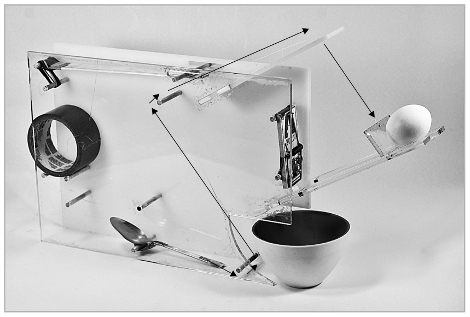
So you’re master of electrons; able to program multiple chip architectures without batting an eye. Good for you. The only problem is that blinking LEDs gets boring after a while and you’re going to want to do something else. Here’s a chance to expand on your physical construction skills. Make: Skill Set is sharing the first chapter from the book Making Things Move by [Dustyn Roberts].
This chapter, which comes in PDF form, covers simple machines. It’ll guide you through the three different types of levers, including examples of how you use these in your everyday life. Next it’s on to pulley systems, wheels and axles, inclined planes and wedges, screws, and gears. [Dustyn] rounds out the chapter by talking about how these concepts are combined into machines like the Rube-Goldberg device seen above. Take some time to look this chapter over and then put it on the holds list from your public library if you’re interested in reading more.
















i cheat at this part … mechanical prototypes are allways meccano or erector set lmao
Thanks for giving the mech guys some “hacking” props!
I think having more mechanical stuff on here is an awesome idea. This, however, seems a little like advertising. It’s one (non particularly useful) chapter which isn’t so much “free” as it is a sample to interest people in the full book. A proper book review, in my opinion, would have been more appropriate than presenting this as “hay guise, free stuff!”.
Unrelated, I thought we had finally gone back to the classic HaD black-and-white photographs with the taped edges. Then I realized it was just because the book was black-and-white. Now I am slightly disappoint :[
Finally something I can help people on haha
“So you’re master of electrons; able to program multiple chip architectures without batting an eye.”
WTF? That doesn’t make you master of electronics at all!
It does in the same way reading that book will make you a mechanical engineer.
“Mechanical Engineering Primer” is a fairly poor choice of title. What you’re talking about is a mechanization primer. I.e. the “mech” part of mechatronics. I just figured that as an ME PhD I’d bring this up, since there is a lot more to mechanical engineering than this, and I felt bad for all the mechanical engineers who might see this and think all their classes except for kinematics and dynamics were fluff.
More mechanisms than you can shake a lever at!
I was unsurprised to see that The Way Things Work, by David Macauly is one of the references for the first chapter. Spend the extra 5 bucks on Amazon to buy The Way Things Work.
It’s written for children and teens (it’s got nothing but pictures of mammoths pulling levers, turning screws, flying planes, etc.) but the information on mechanics, electricity/electronics, fluids, optics, etc. are plenty detailed.
Imperial units alert!
@DeadlyDad
thankyou for the link! absolutely what i’ve been looking for for ages!
Book author here! Great comments…
r_d: I’m told a proper book review will be in the next print version of Make magazine (coming out next month I believe). We’re also going to post another chapter through Make in a week or two – hopefully you find that one more useful! Publishing in color would have priced it out of the target market and made it more of a textbook than a “trade” book, but check the book’s website for color photos and videos.
hooptey: As a fellow ME PhD, I totally agree with you. I’ve heard ME described as the liberal arts of engineering, and I think that’s fitting. This book covers an practical intro to just one subcategory of ME (with some EE thrown in so we can move electrons around)
Another BSME: I has actually never heard of that book until I started writing and my editor mentioned it! Amazing.
grunt: Alas, many machines (lathes, mills, etc) are still manufactured with imperial units in mind (on dials and such), and just about every machine shop in the US I’ve worked with prefers part files in imperial for that reason. Maybe I’ll get a chance to do a metric version in an updated edition!